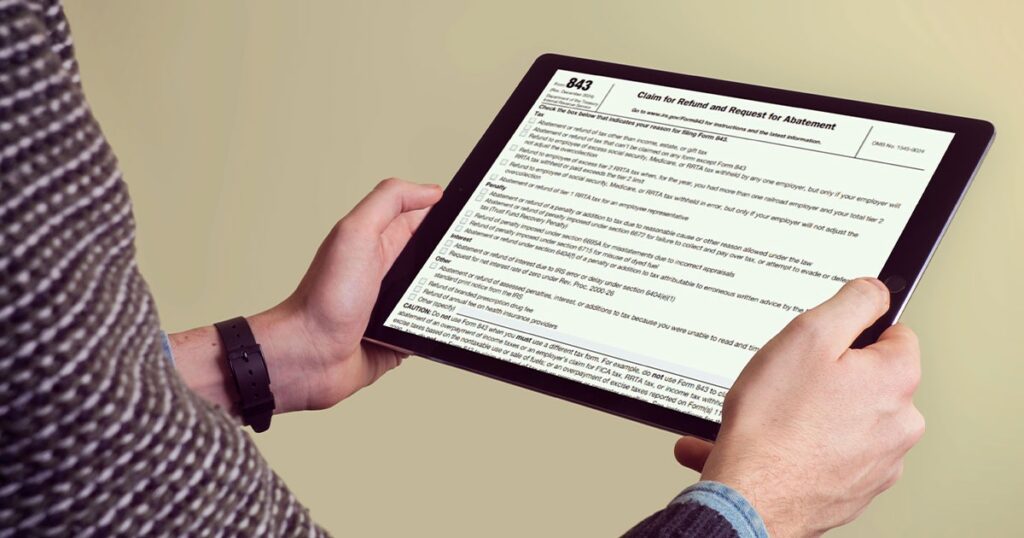If you’ve ever dealt with unexpected IRS penalties or interest charges, you may have come across Form 843. While working with clients on bookkeeping cleanup services, we often see past financial discrepancies that lead individuals to research this form—especially when those charges don’t quite add up. Understanding how Form 843 works can help you make sense of IRS notices and whether you’re eligible for a reduction or refund of certain fees.
What Is Form 843?
Form 843, titled Claim for Refund and Request for Abatement, is used to request the IRS to cancel or refund specific penalties, interest, or certain taxes that were assessed incorrectly or unfairly. This form is commonly filed when:
- You were charged a penalty for missing a deadline due to reasonable circumstances (like a serious illness or natural disaster).
- The IRS charged interest on a balance that wasn’t actually owed.
- You’ve already paid a fee that wasn’t legally required.
It’s important to note that Form 843 is not used for requesting refunds of regular income tax overpayments. For that, you’d need to file an amended return using Form 1040-X.
What Does Abatement of Taxes Mean?
In IRS language, abatement means eliminating penalties or interest charges that were wrongly applied. According to the IRS, First Time Penalty Abatement (FTA) is one of the ways to seek relief through Form 843.You may be eligible for penalty relief through the IRS’s FTA policy if the following conditions apply:
- You either weren’t required to file a return previously or have no penalties on file for the three years before the year the penalty was assessed.
- You’ve filed all required current tax returns or have a valid extension in place.
- You’ve paid, or made arrangements to pay, any taxes you owe.
Understanding what abatement of taxes means can clarify your options—it’s not about avoiding taxes but correcting charges that shouldn’t have been applied in the first place.
Form 843 Instructions: How to File It Correctly
While Form 843 is only one page long, accuracy matters. Here’s a simplified breakdown of the steps based on current Form 843 instructions:
- Enter Your Personal Information: Begin by providing your full name, current address, and either your Social Security Number (SSN) or Employer Identification Number (EIN). If applicable, include your spouse’s SSN for jointly filed returns.
- Specify the Tax Year or Period: In this section, indicate the exact tax year or period you are requesting an adjustment for. This helps the IRS process your request efficiently by linking it to the right filing period.
- Identify the Tax, Penalty, or Fee: Clearly state the specific penalty, interest, or fee you are requesting to be abated or refunded. This is crucial for the IRS to understand which charges are under dispute.
- Provide a Detailed Explanation: In Part II of the form, thoroughly explain the reasons for your request. Be precise and provide any relevant facts that justify your claim, such as errors made by the IRS or reasonable cause for your failure to file or pay.
- Attach Supporting Documentation: It’s important to include any relevant records that back up your request. This could include IRS notices, hospital records, proof of natural disaster impact, or any other documentation that supports the basis for your claim.
- Finalize Your Form: After completing all sections, sign and date the form. If filing jointly, your spouse’s signature may also be required. Review all details carefully to prevent processing delays.
Submitting a complete, well-documented request is key to having your claim processed successfully. By following these steps and ensuring that you provide thorough and accurate information, you can improve your chances of receiving the relief you’re seeking.
Can Form 843 Be Filed Electronically?
At this time, Form 843 cannot be filed electronically. The IRS requires you to mail a physical copy of the form along with any supporting documents. Since the form is processed manually, it’s important to review everything carefully before sending.
Where to Mail Form 843
The mailing address depends on the reason for your request. In general:
- If you’re responding to an IRS notice, follow the mailing instructions provided in that notice.
- If the form is not related to a notice, send it to the IRS service center where you normally file your return.
Always double-check the IRS Form 843 instructions for the most up-to-date mailing information.
Can I File Form 843 With My Tax Return?
No—Form 843 is meant to be filed separately from your regular tax return. It’s not designed for correcting income tax errors or requesting standard refunds. Instead, it’s strictly used for penalty and interest issues or specific taxes listed in IRS instructions.
Take Control of Your IRS Issues
Navigating IRS penalties can be frustrating, especially when they stem from older tax years or paperwork errors. While Form 843 offers a path to request relief, organizing your financial records is often the first and most important step toward resolving these issues. By having a clear financial picture, you can more confidently determine if you’re eligible for a refund or abatement—and whether filing this form makes sense for your situation.
Looking to clean up your financial history and avoid future surprises? Understanding forms like 843 is just one piece of the puzzle. Keeping your records accurate year-round can make a huge difference when it comes to managing IRS communications and minimizing unnecessary charges.

